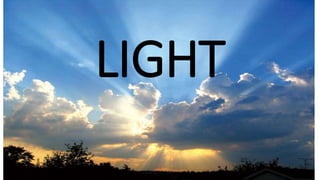
CLASSICAL AND MODERN THOERY OF LIGHT.pptx
- 1. LIGHT
- 2. OBJECTIVES At the end of the lesson, we will be able to: a. Explain different theories of light, b. Differentiate the classical from the modern theories of light, c. Explain how light is reflected, refracted, absorbed and transmitted, d. Differentiate reflection from refraction, e. Explain how the medium by which light travels affects its properties.
- 3. Key Concept • Light is an amazing phenomenon that wonders man for centuries. Light travels at a speed of about 300,000 kilometers per second and can travel around the earth 7.5 times in a mere one second. This property of light is utilized in many technical applications such as optical communications which transfer huge data in a very short time. In recent years, research of such optical phenomenon that occurs in this unbelievably short period of time, is becoming essential in new research on different fields. The exact nature of visible light is a mystery that continues to puzzle scientist from different eras. Thus, speculations arise and different point of views on how light behaves were always been an interesting topic to discuss.
- 4. CLASSICAL AND MODERN THOERY OF LIGHT • CORPUSCULAR THEORY OF LIGHT • WAVE THEORY OF LIGHT • ELECTROMAGNETIC THEORY OF LIGHT • QUANTUM THEORY OF LIGHT
- 5. CORPUSCULAR THEORY OF LIGHT According to this theory proposed by Sir Isaac Newton light consists of tiny particles of matter called corpuscles that move in straight lines. When these corpuscles fall on a smooth surface, they will be reflected. Newton believed that light moves faster as it travels from air into water. An image of the object that we see is produced when these particles enter our eyes. These particles have different colors. Each color has a different size of particles.
- 7. WAVE THEORY OF LIGHT Christian Huygens proposed in 1678 that light is a wave. Light is a series of waves travelling at different speeds in different media. These waves are not affected by gravity. He further explained that reflection, refraction, and the rectilinear propagation of light could be assumed if light would be considered as a wave travelling a medium. Further more, he insisted that the speed of light decreases as it travels from air to water and vice versa.
- 9. ELECTROMAGNETIC THEORY OF LIGHT • Proposed by James Clark Maxwell, this theory considers light as an electromagnetic wave, having both electric and magnetic properties. • https://www.google.com/search?q=electromagnetic+theory+of+light &sxsrf=ALiCzsbjX90NBkP90oza44pd1hdCmF0amA:1672755376075&s ource=lnms&tbm=vid&sa=X&ved=2ahUKEwjFqPKvy6v8AhUFaN4KHSj BCdIQ_AUoAnoECAEQBA&biw=1366&bih=600&dpr=1#fpstate=ive&vl d=cid:4a8fa0cd,vid:pj_ya0e20vE
- 11. QUANTUM THEORY OF LIGHT • Proposed by Max Planck in 1900, this theory states that light waves travel as packets of energy. He called these packets of energy as quanta or photons.
- 12. • According to Planck's quantum theory, Different atoms and molecules can emit or absorb energy in discrete quantities only. The smallest amount of energy that can be emitted or absorbed in the form of electromagnetic radiation is known as quantum
- 14. Reflection • Reflection occurs when a wave hits boundary between two media where the wave speeds differ, but the wave stays in the original medium instead of passing into the second medium. The angle of incidence equals the angle of reflection.
- 15. REFRACTION • refraction, in physics, the change in direction of a wave passing from one medium to another caused by its change in speed. For example, waves travel faster in deep water than in shallow.
- 16. ABSORPTION OF LIGHT • Light absorption is the process in which light is absorbed by matter and converted into energy.
- 17. TRANSMISSION OF LIGHT • The transmission of light occurs when light hits an object that is transparent or translucent and light can penetrate the material to travel all the way through. When light transmission happens, it can be scattered or refracted. Scattering happens when light hits an atom and is sent in all direction
- 18. ACTIVITY
- 19. b
- 21. b